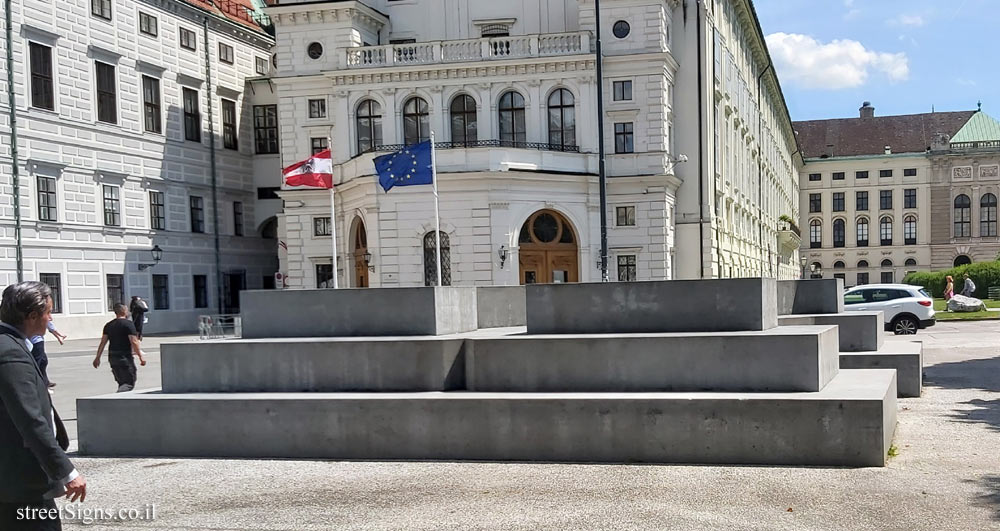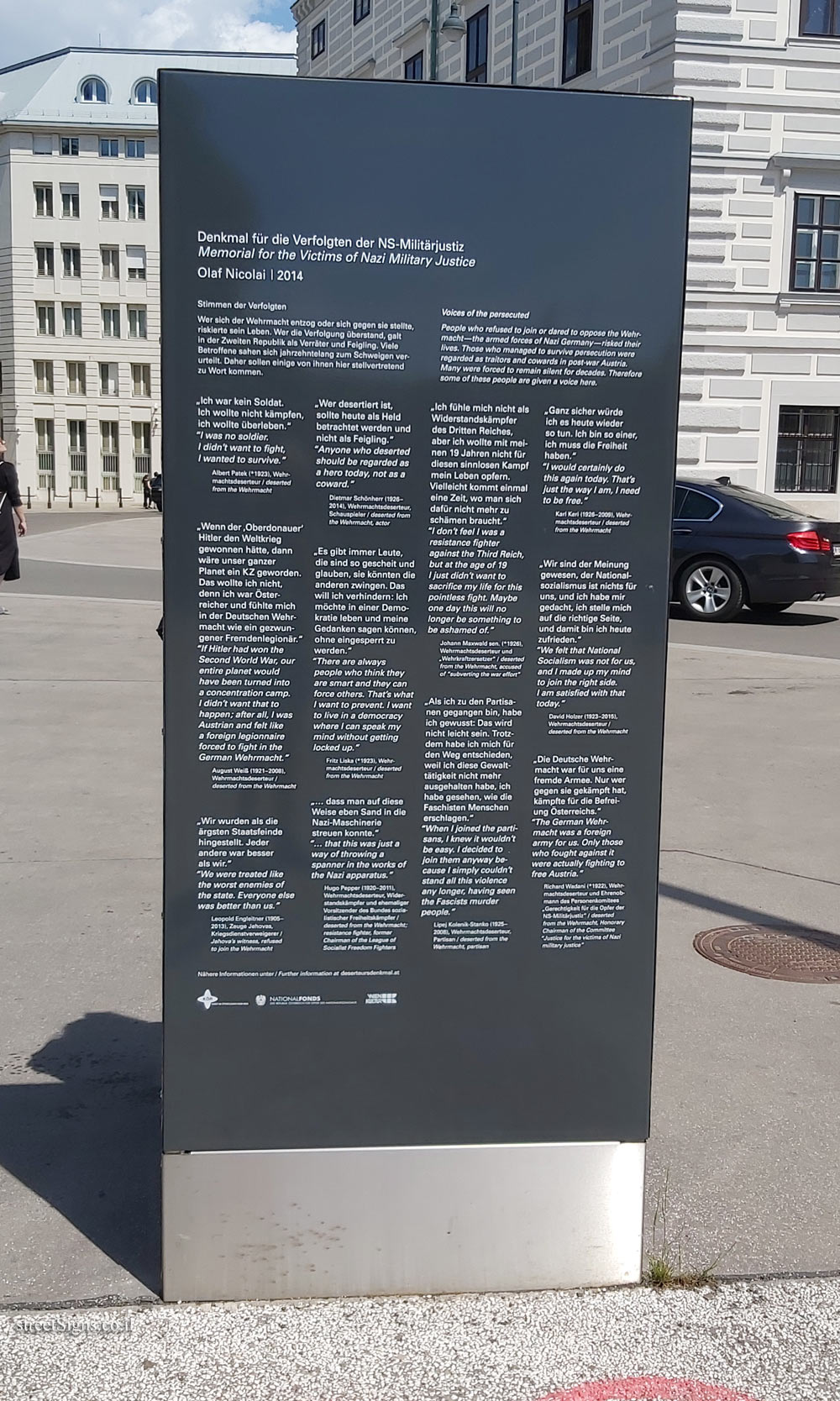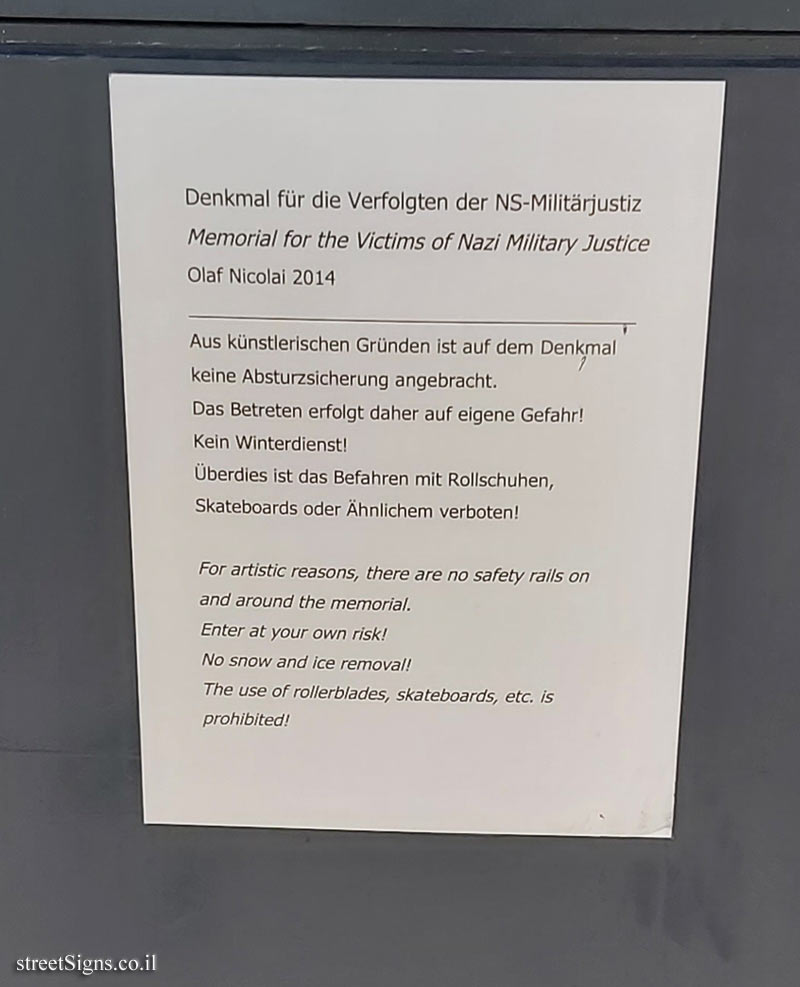Denkmal für die Verfolgten der NS - Militärjustiz
Memorial for the Victims of Nazi Military Justice Olaf Nicolai | 2014
Die nationalsozialistische Militärjustiz verhängte während des Zweiten Weltkrieges mehr als 30 000 Todesurteile: gegen Soldaten , Kriegsgefangene und ZivilistInnen, insbe sondere aus den von der Wehrmacht besetzten Gebieten in ganz Europa. Die meisten Todesurteile ergingen gegen Deserteure und "Wehrkraftzersetzer". Viele tausend weitere Soldaten starben nach kriegsgerichtlichen Urteilen in sogenannten Bewährungseinheiten an der Front.
Die bestraften Handlungen, Lebenswege und biografi schen Hintergründe der Verfolgten sind sehr vielfältig. Vor den Militärgerichten standen politische Gegnerinnen des Nationalsozialismus ebenso wie Menschen, die aus sehr unterschiedlichen Motiven individuelle Freiräume suchten. Jegliche Form der Widersetzlichkeit oder etwa die Unterstützung von Deserteuren durch zivile Helferinnen galten als politische Delikte und wurden mit härtesten Strafen geahndet.
Nach Kriegsende begegnete die österreichische Gesell schaft den Überlebenden dieser Verfolgung mit Ablehnung und Feindschaft. In Österreich hielt sich zwar lange der Mythos, 1938 das "erste Opfer" deutscher Kriegspolitik geworden zu sein. Der Dienst in der "Großdeutschen" Wehrmacht galt jedoch als Pflichterfüllung oder gar als heldenhaft.
Angeregt durch historische Forschungen setzte sich erst ab der Jahrtausendwende die Erkenntnis durch, dass sich die nationalsozialistische Militärjustiz bedingungslos in den Dienst eines verbrecherischen Krieges gestellt hatte. Im Jahre 2009 rehabilitierte der Nationalrat mit den Stimmen der Sozialdemokraten, der Volkspartei und der Grünen die Opfer der Verfolgung durch die Wehrmachts gerichte, und 2010 beschloss die Stadt Wien die Errichtung eines Denkmals für die Verfolgten der NS - Militärjustiz.
Die Skulptur Olaf Nicolais an diesem zentralen Ort der Republik Österreich greift die klassischen Elemente eines Mahnmals "Sockel" und "Inschrift" auf, arrangiert diese aber völlig anders als traditionelle Kriegerdenkmäler. Ein überdimensionales , liegendes , "X" bildet den dreistufigen Sockel, in dessen dritte Ebene die nur von oben lesbare Inschrift eingelassen ist. Der Text zitiert ein Gedicht des schottischen Künstlers lan Hamilton Finlay (1925-2006), der mit wichtigen Vertreterinnen der sprachkritischen und experimentellen Wiener Künstlerszene befreundet war.
[X with the words all alone]
, all / alona , 1964
* Das Zusammenspiel von Sockel und Inschrift inszeniert die Situation des Einzelnen in und gegenüber gesell schaftlichen Ordnungs- und Machtverhältnissen . Bedroht von Anonymisierung und Auslöschung , die ihn zum "X" in einer Akte werden lassen, ist seine Position dennoch zentral.
Die Skulptur erweist denjenigen Respekt , die eine eigene Entscheidung treffen, sich der Fremdbestimmung widersetzen und sich durch ihr eigenständiges Handeln gegen das geltende System stellen.
During the Second World War Nazi military justice handed out more than 30,000 death sentences: against soldiers, prisoners of war and civilians, in particular from the regions occupied by the German Wehrmacht (armed forces) all over Europe. Most of the death sentences were passed against deserters and "Wehrkraftzersetzer" (subverters of the war effort). Many thousands of other soldiers died at the front after being sentenced by the military courts to serve in "penal battalions".
The actions punished, ways of life and biographical backgrounds of those persecuted varied widely. Political opponents of Nazism faced the military courts just as much as people who were looking for individual freedom for very different reasons. Any form of resistance or, for example, support for deserters by civilian helpers was regarded as a political crime and was thus punished with the greatest severity.
After the end of the war, Austrian society met the survivors of this persecution with rejection and hostility. Because in Austria for a long time the myth continued that in 1938 it was made the "first victim" of German war policy; yet the service of Austrian soldiers in the "Groß-deutsche Wehrmacht" was considered to be the fulfillment of duty or even heroic.
Inspired by historic research, it was only after the turn of the century that the recognition prevailed that Nazi military justice had put itself unconditionally at the service of a criminal war. In 2009, with the votes of the Social Democrats, the People’s Party and the Green Party, Austria’s National Assembly rehabilitated the victims of the persecution by the Wehrmacht courts, and in 2010 the City of Vienna decided to erect a monument to the victims of Nazi military justice.
The sculpture by Olaf Nicolai on this central location of the Austrian Republic takes up the classical elements of a memorial, the "pedestal" and the "inscription" . Yet it arranges these completely differently than in traditional war memorials. An outsized, lying "X" constitutes the three-step pedestal, on the third level of which the inscription is embedded. The text is only readable from above and quotes a poem by the Scottish artist Ian Hamilton Finlay (1925-2006), who was friends with important representatives of the language-critical and experimental Viennese artists’ scene.
The interplay between pedestal and inscription stages the situation of the individual in and toward the social order and power relations. Threatened by anonymization and extinction, which turn him into an "X" in a file , his or her position is nonetheless central.
The sculpture demonstrates respect for all those who take their own decision, defy heteronomy and through their independent action position themselves against the prevailing system.
Nähere Informationen unter / Further information at
deserteursdenkmal.at * Ian Hamilton Finlay , all / alone, 1964 , mit freundlicher Genehmigung der / courtesy of Wild Hawthorn Press
[Second Board]
Denkmal für die Verfolgten der NS - Militärjustiz
Memorial for the Victims of Nazi Military Justice Olaf Nicolai | 2014
Stimmen der Verfolgten
Wer sich der Wehrmacht entzog oder sich gegen sie stellte, riskierte sein Leben. Wer die Verfolgung überstand , galt in der Zweiten Republik als Verräter und Feigling. Viele Betroffene sahen sich Jahrzehntelang zum Schweigen ver urteilt. Daher sollen einige von ihnen hier stellvertretend zu Wort kommen.
Voices of the persecuted
People who refused to join or dared to oppose the Wehrmacht - the armed forces of Nazi Germany - risked their lives. Those who managed to survive persecution were regarded as traitors and cowards in post-war Austria. Many were forced to remain silent for decades. Therefore some of these people are given a voice here.
"Ich war kein Soldat. Ich wollte nicht kämpfen, ich wollte überleben."
"I was no soldier. I didn’t want to fight, I wanted to survive."
Albert Patek (1923), Wehr machtsdesertour / deserted from the Wehrmacht
"Wenn der Oberdonauer’ Hitler den Weltkrieg gewonnen hätte, dann wäre unser ganzer Planet ein KZ geworden. Das wollte ich nicht, denn ich war Öster reicher und fühlte mich in der Deutschen Wehr macht wie ein gezwun gener Fremdenlegionär."
"If Hitler had won the Second World War, our entire planet would have been turned into a concentration camp. I didn’t want that to happen; after all, I was Austrian and felt like a foreign legionnaire forced to fight in the German Wehrmacht."
August Weiß (1921-2008), Wehrmachtadesertour / deserted from the Wehrmacht
"Wir wurden als die ärgsten Staatsfeinde hingestellt. Jeder andere war besser als wir."
"We were treated like the worst enemies of the state. Everyone else was better than us."
Leopold Englaeitnar (1905 2013), Zeuge Jehaves, Kriegsdienstverweigerer / Jehova’s witness ,refused to join the Wehrmacht
"Wer desertiert ist, sollte heute als Held betrachtet werden und nicht als Feigling."
"Anyone who deserted should be regarded as a hero today, not as a Coward."
Dietmar Schönherr (1926 2014) , Wehrmachtsdesertour, Schauspieler / deserted from the Wehrmacht, actor
"Es gibt immer Leute, die sind so gescheit und glauben, sie könnten die anderen zwingen. Das will ich verhindern: Ich möchte in einer Demo kratie leben und meine Gedanken sagen können, ohne eingesperrt zu werden."
"There are always people who think they are smart and they can force others. That’s what I want to prevent. I want to live in a democracy where I can speak my mind without getting locked up."
Fritz Liska (1923 ), Wehr machtsdeportour / deserted from the Wahrmacht
"... dass man auf diese Weise eben Sand in die Nazi-Maschinerie streuen konnte."
"... that this was just a way of throwing a spanner in the works of the Nazi apparatus."
Hugo Pepper (1920-2011) . Wehrmachtadesertour, Wider staradakdimpler und ahomoliger Vorsitzender des Bundes uaris Theitsklopfer / deserted from the Wehrmacht; resistance fighter, former Chairman of the League of Socialist Freedom Fighters
"Ich fühle mich nicht als Widerstandskämpfer des Dritten Reiches, aber ich wollte mit mei nen 19 Jahren nicht für diesen sinnlosen Kampf mein Leben opfern. Vielleicht kommt einmal eine Zeit, wo man sich dafür nicht mehr zu schämen braucht."
"I don’t feel I was a resistance fighter against the Third Reich but at the age of 19 just didn’t want to sacrifice my life for this pointless fight. Maybe one day this will no longer be something to be ashamed of."
Johann Maxwald son. (1926) , Wehrmachtadepertour und Wehrkraftzersetzer / deserted from the Wehrmacht , accused of "subverting the war effort"
"Als ich zu den Partisa nen gegangen bin, habe ich gewusst: Das wird nicht leicht sein. Trotz-dem habe ich mich für den Weg entschieden, weil ich diese Gewalt tätigkeit nicht mehr ausgehalten habe, ich habe gesehen, wie die Faschisten Menschen erschlagen."
"When I joined the partisans, I knew it wouldn’t be easy. I decided to join them anyway because I simply couldn’t stand all this violence any longer, having seen the Fascists murder people."
Lipej Kalanil - Stanko (1925 2008) , Wahrmachadonertour Partisan / deserted from the Wehrmacht , partisan
"Ganz sicher würde ich es heute wieder so tun. Ich bin so einer, ich muss die Freiheit haben."
"I would certainly do this again today. That’s just the way I am, I need to be free."
Karl Kari (1926-2000 , Wahr machtsdeserteur / deserted from the Wehrmacht
"Wir sind der Meinung gewesen, der National sozialismus ist nichts für uns, und ich habe mir gedacht, ich stelle mich auf die richtige Seite, und damit bin ich heute zufrieden."
"We felt that National Socialism was not for us, and I made up my mind to join the right side. I am satisfied with that today."
David Holzer (1923-2015), Wehrmachtsdesertour / deserted from the Wehrmacht
"Die Deutsche Wehr macht war für uns eine fremde Armee. Nur wer gegen sie gekämpft hat, kämpfte für die Befrei ung Österreichs."
"The German Wehrmacht was a foreign army for us. Only those who fought against it were actually fighting to free Austria."
Richard Wadani (1922) , Wahrmachtsdevertour und Ehrenob mann des Personenkomitees Gerechtigkeit für die Opfer der NS - Militärjustia / deserted from the Wehrmacht ,Honorary Chairman of the Committee Justice for the victims of Nazi military justice
Nähere Informationen unter / Further information at
deserteursdenkmal.at

 Click for a larger image
Click for a larger image  Click for a larger image
Click for a larger image  Click for a larger image
Click for a larger image